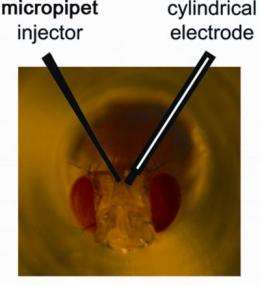A tiny electrode and pipette inserted into the fruit fly brain make it a simple, convenient model for studying drug abuse in humans. Credit: American Chemical Society
Fruit flies may seem like unlikely heroes in the battle against drug abuse, but new research suggests that these insects — already used to study dozens of human disease — could claim that role. Scientists are reporting that fruit flies can be used as a simpler and more convenient animal model for studying the effects of cocaine and other drugs of abuse on the brain. Their study appears online in ACS Chemical Neuroscience, a new monthly journal.
Andrew Ewing and colleagues note that laboratory mice, rats, and monkeys have been mainstays in research with the ultimate goal of finding effective medicines for treating addiction. Although these mammals have helped establish the behavioral effects of cocaine on the body, they provide relatively complicated models to study the effects of cocaine and other illicit drugs on the brain and nerves. In the hope for a new simpler animal model they turned to fruit flies, which have many biological similarities to mammals, but are easier to study.
The scientists confirmed those hopes in research that involved giving cocaine, amphetamine, methamphetamine, and methylphenidate to fruit flies and then studying brain chemistry with a microelectrode one-twentieth the diameter of a human hair. The results demonstrate that fruit flies are a valid model for studying drug addiction in humans, the scientists say.
More information: "Using in Vivo Electrochemistry To Study the Physiological Effects of Cocaine and Other Stimulants on the Drosophila melanogaster Dopamine Transporter", pubs.acs.org/stoken/presspac/p … ll/10.1021/cn900017w
Source: American Chemical Society (news : web)


















